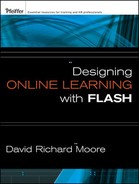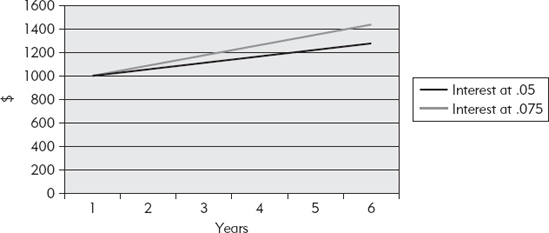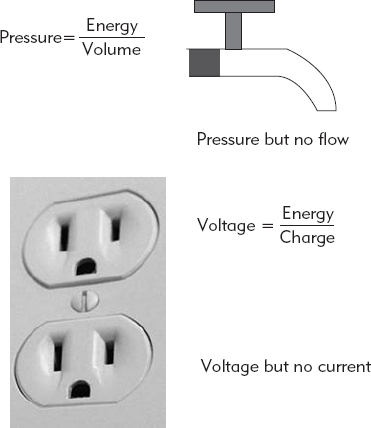Guiding Questions
What is a Principle and how does it relate to Facts, Concepts, and Procedures?
What is the role of causation in teaching Principles?
What is the difference between a Rule and a Principle?
How do you identify instances of the Principle learning domain?
Why are examples important when teaching Principles?
Why is the range of a Principle important?
What strategies are appropriate for presenting content in the Principle learning domain?
How do you create practice sequences for the Principle domain?
In this chapter, you will learn about teaching Principles.
A Principle describes how two or more Concepts are related, as well as describes that relationship. Principles are used to answer questions such as, "Why does it happen that . . .?" and "What will happen if . . . ?". Principles are challenging to learn because they require knowledge of Facts, Concepts, and Procedures as prerequisites.
A Principle describes how two or more Concepts are related and provides an explanation for that relationship. You can summarize a Principle with a rule or a set of rules. Rules describe a relationship between Concepts, but they do not explain that relationship. For example, Einstein used the rule e = mc2 to describe the relationships among the Concepts energy, mass, and speed; however, developing an understanding of the implications of that rule require additional explanation. In other words, mastering a rule is a necessary but not sufficient task in mastering a Principle.
Someone who has mastered a Principle can use its rules as shorthand to describe the essence of a Principle. However, when you are teaching a Principle you must explicitly provide an explanation or a rationale, and not merely state the summarizing rule and assume the learners have fully understood the relationships among Concepts. An explanation makes a rule more comprehensible by describing the causal relationships involved and their implications. The rationale is important because it provides context to assist the learners in generalizing the Principle to new situations.
Rules are necessary components of Principles; however, they are limited because they do not provide the learner with enough information to generalize to unique situations. A rule is a proposition, often in the form of, IF x THEN y, while a Principle needs to be in the form of IF x THEN y, BECAUSE of z. For example, a Rule might be, IF the stop light is red, THEN stop, while a Principle would add, BECAUSE while you are receiving a red signal others are seeing a green signal which, by convention, gives them permission to proceed. If the signals are not followed by appropriate action, then vehicles will not be able to alternate through the intersection, causing slowdowns and possibly accidents. This explanation provides context for the learners to understand the purpose and function of the Principle.
Rules are easy to understand when they are in the stated as IF-THEN propositions. However, IF-THEN relationships that constitute rules are not always explicit. For example, the statement, "It is important to brush your teeth before you go to bed" is a proposition but not in the IF-THEN format. However, the proposition is clearly implied: IF you have teeth, THEN brush them before you go to bed. Once again, the rule does not rise to the status of a Principle because an explanation is not provided. If the learner understands that brushing one's teeth removes plaque, which prevents tooth decay, then he or she would be closer to mastering the Principle. As a designer, you should remember that all Principles consist of rules, but rules are not equivalent to Principles.
Teaching rules without explanations encourages learners to learn by rote, which results in only surface-level learning. This distinction is important because without an explanation rules may become the source of misconceptions and even superstition. For example, Newton's Third Law of Motion states that, for every action there is an equal and opposite reaction. However, the Third Law is often counter to common experience, such as a bullet exiting a gun barrel. The mass of the gun and of the shooter is so large in comparison to the bullet that the reaction is hidden from plain view. Without an explanation of why this might be the case; without a rationale, a learner is encouraged to merely memorize the rule without connecting it to the learner's larger cognitive structure. A learner should be suspicious of unexplained rules, and designers should make the effort to explain them.
Principles generally demonstrate two types of relationships between concepts: (1) directly causal relationships and (2) probable relationships. A directly causal relationship indicates that a change in one Concept will have a knowable and measurable change in another Concept. A probable relationship suggests that there may be only a chance that a change in one Concept will result in a change in another Concept and that the magnitude of the change is not known for certain. For example, a description of a molecule describes the relationship between elements with mathematical certainty. However, a description of a management technique is probable because the technique may not be effective in every situation. It should be apparent that, when teaching a learner a Principle that describes probable relationships, more explanation and context are required to help the learner understand the uncertainty involved in the relationship.
Facts, Concepts, and Procedures are primarily descriptive in nature. They help the learners to define phenomena. Principles, on the other hand, have implications. Learners should always be encouraged to consider the implications of the Principles they are learning. For example, if they are studying Newton's Laws of Motion, they should be encouraged to consider how those laws apply to divergent examples such as feathers and bricks. They should be prompted to ask questions such as, What are the implications of changing Mass in the equation? What are the consequences of changing Force in the equation?
A common direct strategy for teaching Principles is to review Concepts involved and then to simply explain the Principle's rules and provide the learners with a rationale. This is followed by a series of examples that describe the implications of the Principle. Initially, the learners may have to memorize the rule. An explanation will assist the learners in integrating it into their cognitive structure. Once the learners begin to work with applying the Principle, the less they will have to memorize by rote; the rule will be contextualized, making it easier to retain. For example, Exhibit 10.1 demonstrates how an explanation might be presented.
Another example of a direct strategy is to demonstrate the application of a Principle. For example the graph in Figure 10.1 demonstrates how the Future Value of Money can change based on modifying the Interest Rate.
With a discovery strategy, the learners must find and construct the Principle themselves; they must infer the rule and explanation from a series of instances. For example, Exhibit 10.2 demonstrates a question that might be posed to learners. In this example, the learners are provided only a general framework to begin their investigation.
Another example of a discovery strategy would be to provide the learners with a pattern to see whether they can find a mathematical relationship (as demonstrated in Figure 10.2).
Can you find a mathematical equation to describe the process involved?
Learners can be judged to have mastered a Principle when they can identify the implications of its application to an un-encountered situation. In support of that goal, they should be able to accurately state a Principle's rule and describe its constituent Concepts.
Principle presentations are taught using three types of strategies: (1) attention management, (2) cognitive load management, and (3) structural management. These strategies align with sensory memory, working memory, and long-term memory.
Like the other learning domains, clarity is of utmost importance when you are designing instructional strategies. The learners must have a clear, unambiguous description of a Principle's rules, rationale, and examples. How each of these components may be presented has been previously discussed; however, an addition that might be considered is to ensure that learners know when they are doing each of these steps. For example, when you are teaching a series of Principles, each screen should have a similar layout for each piece of the lesson. For example, if you are teaching Concepts, the screen should clearly inform the learners of this task.
Managing attention while teaching Principles is largely a matter of drawing the learners' focus to different aspects of the constituent Concepts, summarizing rules and rationale. Being able to focus on a particular aspect first requires the learners to be able to distinguish one thing from another. The figure must be separated from the ground. In other words, support must be provided to highlight elements that are being discussed to make it easier for the learners to identify one component from another.
Likewise, when a Rule is being presented, the screen should have a similar interface to previously encountered Rule screens. Compare Exhibit 10.3 with Exhibit 10.5; notice that the same screen layout is used to reinforce the instructional task.
Demonstrating mastery of a Principle is a multi-stepped process. To demonstrate mastery, learners must: (1) recognize the constituent concepts, (2) state the underlying rule, (3) comprehend the associated explanation and rationale, (4) identify situations in which the Principle is and is not applicable, (5) appropriately apply the Principle, and (6) evaluate whether or not the principle accomplishes the intended task. Each of these steps highlights a different aspect of the Principle domain of knowledge and you, as a designer, should be prepared to provide instruction for each stage, as well as to provide assessment opportunities that evaluate each aspect.
One of the first steps in teaching a Principle is to familiarize the learners with its constituent Concepts. If the learners have not mastered these Concepts, they will not be capable of mastering the Principle.
For example, if you were to teach the Principle of the Future Value of Money, you would first identify the constituent Concepts. The learners must master the Concepts, Value and Rate of Interest, to understand the rule. For details, on teaching these Concepts, refer to Chapter 9. Exhibit 10.4 describes how the Concept of Value might be introduced.
Once the prerequisite Concepts are understood, the learners can proceed to learning the rule that summarizes a Principle. Although understanding a Principle requires more than being able to state its rule, knowing the rule is an important initial step.
Stating the rule is declarative knowledge (discussed in the Chapter 8). However, knowing the rule is a necessary, just not sufficient, condition for Principle acquisition. For example, Exhibit 10.5 is an equation describing the time value of money.
Learners must be able to recall the equation in some situations (What is the equation of the Future Value of Money?) or be able to select it when presented with similar equations (Which of these equations would you use to determine the Future Value of Money?
FV = rr + I,
FV = PV(1 + i)n,
FV = D C /D S).
Initially, the learners should be presented with a Principle's rule, and in some cases they should be provided a mnemonic to assist them in recalling the rule. However, once the learners begin to work with applying the Principle, the less they will have to memorize by rote. The rule will be contextualized, making it easier to retain, and they will not have to rely on mnemonics.
Learners must be able to associate the Principle statement (summarizing rule and explanation) with a demonstration of an example; this can be done by displaying both simultaneously on the same screen. By sharing the screen in this manner, you can help conserve the learners' cognitive resources; they do not have to switch back and forth and try to recall what was previously presented.
The learners will have to respond to a Principle statement with an example and, when presented with an example, respond with a Principle statement. The Principle statement acts as cue for the learners and can eventually be faded away and eliminated, as demonstrated in Figure 10.3 and Exhibit 10.6.
You should assist the learners by organizing Principles so that they are compatible with the learners' cognitive structures. By considering how a Principle can fit in with long-term memory, you can assist the learners in consolidating their understanding.
Enhancing learners' ability to generalize and discriminate the Principle is an act of helping them use it appropriately; it is an act of helping them find the range of the Principle. Learners need to know in what circumstances the Principle can be used and in what circumstances the Principle does not apply. Presenting the learners with examples and non-examples is critical if the learners are going to develop this type of discernment.
To evaluate learners' ability to apply a Principle, you must provide them with a series of un-encountered examples. Examples must be un-encountered to prevent the learners from demonstrating memorization instead of Principle mastery. To demonstrate complete Principle mastery, the learners must be able to state the summarizing rule, provide a cogent explanation, and use the Principle to predict some phenomena.
Presenting the learners with both example and non-examples of a Principle can help them integrate content into their cognitive structure. For example, the learners may be learning about the Principle of gravity. Even though they may have been introduced to the idea that gravity is a function of the masses of the objects and the distance between them, they may fail to recognize this in practice. They may know that gravity is present on the earth, because they see objects fall to the ground; however, they may see a film of astronauts on the moon and see objects floating and taking longer to land on the surface. As a result of this differential between actions on the earth and those on the moon, the learners may not make the connection that gravity is active on the moon, and is, in fact, active everywhere in the universe.
This misconception is common and can be addressed directly. By sharing a wide range of examples with the learners, the Principle has a better chance of being integrated into the learners' cognitive framework. Learners might also mix up gravity with another source of Force, perhaps Magnetism. By sharing with the learner examples of both gravity and magnetism, they will have a better opportunity to classify them.
Another strategy is to present the learners with an analogy of the Principle. This allows them to connect the Principle (something unknown) with the analogy (something known). For example, volts in an electrical circuit are often compared to the pressure of water. Figure 10.4 compares the two phenomena.
Finally, it may be helpful to demonstrate to the learners how the Principle can be reorganized or modified. For example, a Principle that can be expressed as an equation can be reorganized algebraically. In the case of the time value of money equation, because the rule is expressed in a formal equation, it can be manipulated algebraically, as demonstrated in Exhibit 10.7.
This reorganization can maintains the essential relationships within the summarizing rule but may broaden the Principles applicability. The reorganization may also help the learners to connect the material to their cognitive structures.
One of the most powerful types of discovery teaching strategies is to establish a simulation. A simulation allows the learners to manipulate one or more variables and have the consequences demonstrated on the screen. A learner engaged in a simulation is active in both constructing Principles and applying them. Flash is a particularly effective tool for implementing this type of teaching strategy. Simulations allow the learners to apply their knowledge by making decisions and proposing hypothesis; by doing so the learners can get a feel for the implications of their actions.
For example, any equation can be used to create a simple simulation. With some simple Flash ActionScript coding, the learners can be permitted to input or select a value for one of the variables. This input can be used to control the graphics on the screen. In this way the learners can make hypotheses and immediately test them out. By doing this, they can construct mental models of how dependent variables relate to independent variables.
Figure 10.5 shows a simulation of a nuclear reactor. The learner can manipulate a number of variables and view the result.
One of the benefits of a simulation is that it helps the learners understand the type of relationships that exist among the Principle's constituent Concepts. A relationship that is directly causal will respond consistently, while a relationship that is probable will show some variation with the same settings. A probable relationship will have to be programmed with some randomness designed in. For example, a sales training application may be teaching the importance of evaluating potential buyers. The learners could be given a list of attributes of their product's ideal demographic, that is, they are told to identify unmarried, college educated males with an income between $35,000 and $45,000 who work in the financial industry. A simulation could be created with a virtual population the learners could select from. Since sales are probabilistic by nature, the learners could only hope to sell to a prospect a certain percentage of the time. The simulation could be designed so that a prospect selected with this demographic profile would buy 15 percent of the time, while someone who did not fit this profile would only buy 2 percent of the time. In this way, the learners can develop a feel for how prospect and prospecting relate to sales.
Learners using a simulation should be asked, before a simulation begins, to predict not only the type of relationship that the Principle proposes, but the magnitude as well. In the previous example, the learners should be asked, prior to beginning, questions such as, "What is your target population?" "How many sales do you think you can make to this population?" "How much does identifying the appropriate clients mean to your success rate?" "How much of your success is due to luck?" "How much of your success rate is due to your presentation skills?" "How many potential clients do you expect to meet to make a sale?" By having learners create hypotheses first, the simulation can then provide them a forum to test and alter their assumptions. In this manner, the Principle can emerge from the learners' experience with the simulation.
Learning presentations are designed to manipulate content to provide support to the learners. Practice sequences have the opposite purpose. Practice sequences attempt to remove or fade support for the learners. Each type of learning strategy has its own unique sequences. Table 10.1 is a sample of how these sequences might be implemented. It should be noted that rarely would all of these sequences be necessary to achieve any particular learning objective.
Table 10.1. Practice Sequences for the Principle Learning Domain
Initial | Intermediate | Exit | |
|---|---|---|---|
Task 1A. Concrete and Familiar: Interest rates are tied to home mortgages. More consumers have been willing to purchase homes when interest rates decrease. What can be predicted if interest rates increase? | Task 1B. Concrete: Interest rates affect home mortgages. What can be predicted if interest rates increase? | Task 1C. Abstract: An increase in interest rates will have what effect on the following products? | |
In the equation below, what constant represents the interest rate [P = C (1 + r/n)nt] | In the equation below which quantity represents the interest rate? [P = X1 (1 + x2/n)nt] | In the equation below which quantity represents the interest rate? [X1 = X2 (1 + X3/X4)nt] | |
Cognitive load management: Learner Action | Recognize: Which of the following equations describes how interest is compounded? | Edit: Modify the equation below so it is appropriate to for compound interest. | Produce: Describe the effects of a change in interest rates on the future value of an investment. |
Compound interest can be described by the equation: P = C (1 + r/n)nt where P = future value, C = initial deposit, r = interest rate, n = # of times per year interest in compounded, t = number of years invested. What are the affects of a change in interest rate on future value? | Compound interest can be described by the equation: P = C (1 + r/n)nt. What are the affects of a change in interest rates of future value. | Interest rates move from.06 to .09. What are the affects on future value? |
The important ideas in this chapter include:







